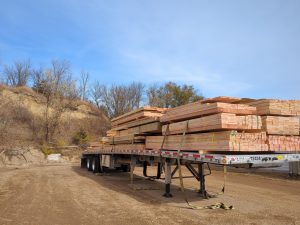Southern Pine lumber has been popular since Colonial times for a wide variety of applications. Favorable growing conditions, wise forest management, and efficient manufacturing ensure a continuous supply of high-quality Southern Pine products for future generations. Southern Pine consists of four main species — shortleaf, longleaf, loblolly, and slash — and has been the preferred choice for today’s design/build professionals.
Visually graded North American lumber is subject to periodic sampling and testing, to verify the product being provided to the public, meets the published design values. These design values are used by architects, engineers and Building Officials to ensure new wood construction is adequate to support the loads which will be imposed upon the structure. If you’ve ever looked at the end of a piece of lumber – this is where you might find “SYP” stamped on it, for Southern Yellow Pine, which is the same as Southern Pine.
 The most recent testing of Southern Pine lumber resulted in a technical proposal by the Southern Pine Inspection Bureau to significantly lower design values. This submittal was reviewed by the Forest Product Laboratory.
The most recent testing of Southern Pine lumber resulted in a technical proposal by the Southern Pine Inspection Bureau to significantly lower design values. This submittal was reviewed by the Forest Product Laboratory.
As a resultant of this review, the American Lumber Standard Committee (ALSC) has ruled the design values which apply to visually graded Southern Pine and Mixed Southern Pine sized 2” to 4” wide and 2” to 4” thick (2x2s through 4x4s) in No.2 and lower grades (No.2DNS, No. 2, No. 2NonDNS, No.3, Stud, Construction, Standard and Utility), will be reduced as much as 30% as of June 1, 2012.
What does this mean? This would be like waking up some morning and finding out the dollar you had is now worth 70 cents. The lumber used in your building, which sizes and grades were chosen based upon your building location and design, now possibly will not meet the building code. The issue here is the design date and your lumber need to match. In other words – if you purchased 2×2, 2×3 or 2×4 size lumber prior to June 1st, it may not be large enough for your construction design.
Down the line, this will affect lumber larger than 2×4’s, but we don’t know when, or “how much” it will be affected. The original SPIB proposal submitted to the ALSC included a reduction in design values of 25-30% for all grades and sizes of visually graded Southern Pine.
The wholesale lumber market has substantially adjusted pricing of Southern Pine to compensate for the lower strength values. In many markets, the now stronger Douglas Fir, Hem-Fir and Spruce-Pine-Fir have gained popularity.
For the end user, the recommendation would be to use larger dimension Southern Pine conservatively, until such time as new values are accepted and published. In using Southern Pine for critical members such as floor joists, rafters, beams and headers it would be prudent to go to the next larger size member than what is shown in span tables.
You can be sure I will have my ear to the ground. I will again blog about Southern Pine, should I find updated information.






